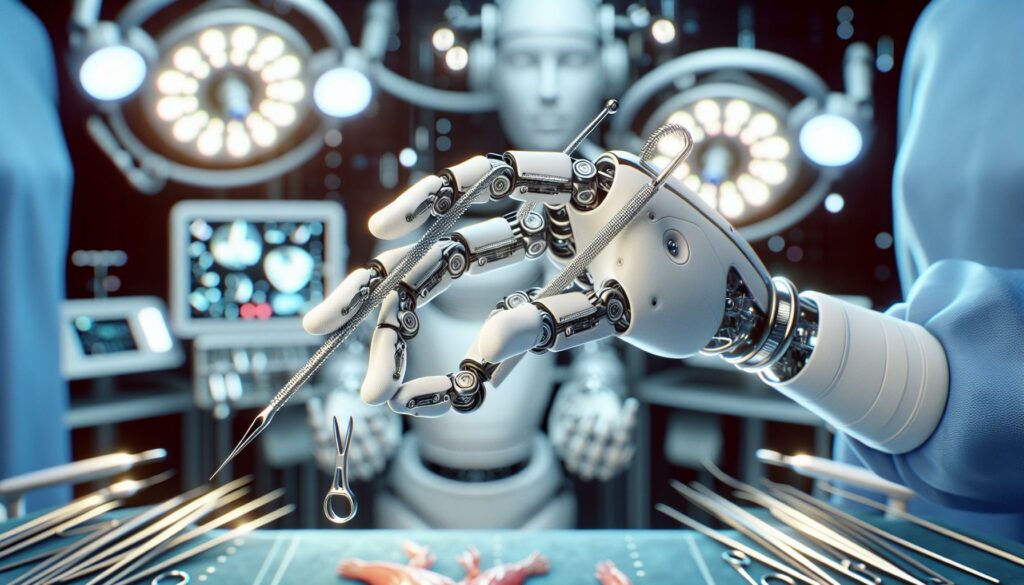In the ever-evolving world of technology, dexterity robotics stands out as a game-changer. These advanced machines are designed to replicate human-like movements, opening doors to countless applications in industries like manufacturing, healthcare, and even home assistance. I’m fascinated by how these robots combine precision and flexibility, allowing them to perform tasks that were once thought to be exclusive to humans. As I dive deeper into this topic, I’ll explore how dexterity robotics not only enhance efficiency but also tackle challenges in environments that require delicate handling. From surgical robots to automated assembly lines, the potential of this technology is limitless. Join me as I uncover the innovations and implications of dexterity robotics in our daily lives and the future of work.
- Definition & Purpose: Dexterity robotics are advanced machines designed to replicate human-like movements, significantly enhancing efficiency across diverse industries.
- Key Features: These robots are characterized by precision, flexibility, real-time feedback, and user-friendly interfaces, making them versatile for various applications.
- Applications: Common uses include surgical assistance in healthcare, automated assembly in manufacturing, and enhanced logistics, demonstrating their effectiveness in both industrial and medical fields.
- Challenges: Dexterity robotics face hurdles such as technical limitations, job displacement concerns, and ethical considerations regarding liability and privacy.
- Future Trends: Emerging innovations in AI, collaborative robots (cobots), advanced materials, and a focus on sustainability are likely to drive the future evolution of dexterity robotics.
Dexterity Robotics
Dexterity robotics combines advanced technology and engineering to create machines that replicate human movements. These robots feature highly articulated limbs and sensitive sensors, allowing them to navigate complex tasks in intricate environments.
Key Features of Dexterity Robotics
- Precision: Dexterity robots perform with remarkable accuracy, executing delicate tasks such as surgery with minimal error.
- Flexibility: These robots adapt to various applications, making them suitable for sectors like healthcare, manufacturing, and logistics.
- Real-time Feedback: Equipped with advanced sensors, dexterity robots provide instant feedback, ensuring tasks align with operational requirements.
- User-friendly Interfaces: Most systems include intuitive interfaces, enabling users to program and control robots easily.
Applications of Dexterity Robotics
- Healthcare: Robots assist in surgical procedures, improving outcomes and reducing recovery time for patients.
- Manufacturing: In this sector, robots streamline assembly lines, increase production rates, and maintain quality standards.
- Research & Development: Researchers employ these robots to explore new methods and innovations across various fields.
- Enhanced Efficiency: Dexterity robotics minimize downtime and increase throughput by working faster than human operators.
- Improved Safety: These machines often perform hazardous tasks, reducing the risk of injury in the workplace.
- Cost-effectiveness: Investing in dexterity robotics can lead to lower operational costs over time by optimizing workflow.
Dexterity robotics represents a significant leap toward creating intelligent automation solutions, reshaping industries and altering the future of work.
Key Technologies in Dexterity Robotics
Dexterity robotics rely on several core technologies that enable precision and efficiency in various applications. Two key technologies are robotic hands and sensory feedback mechanisms.
Robotic Hands
Robotic hands possess articulated joints and actuators, allowing for natural hand movements. These hands can grasp, manipulate, and perform intricate tasks. Advanced designs incorporate materials that offer flexibility and strength, ensuring the safe handling of delicate items. For instance, soft robotics uses silicone and flexible materials, enhancing grip without damaging fragile objects. Some robotic hands include adaptive grippers that adjust based on object shape and size, improving versatility across diverse environments.
Sensory Feedback Mechanisms
Sensory feedback mechanisms play a significant role in enhancing the capabilities of dexterity robotics. These systems provide real-time data regarding pressure, position, and texture. For example, force sensors equipped in robotic hands alert the system to apply the appropriate grip strength. Tactile sensors allow robots to detect texture changes, facilitating nuanced handling techniques. Integrating these feedback systems enables robots to adapt their actions based on environmental variables, improving both accuracy and safety in complex tasks.
Applications of Dexterity Robotics
Dexterity robotics play a crucial role across various sectors, enhancing efficiency and effectiveness in tasks requiring precision and flexibility. I’ll explore key applications in industrial and medical fields.
Industrial Use Cases
Dexterity robotics significantly impact manufacturing, logistics, and assembly operations. They automate complex processes, reduce cycle times, and ensure high quality. Key use cases include:
- Automated Assembly: Robots assemble components with precision, improving throughput and meeting quality standards.
- Quality Control: Vision systems integrated with robots inspect products, identifying defects faster than human inspectors.
- Material Handling: Robots transport materials across plants, optimizing supply chains and reducing labor costs.
- Customized Production: Flexible robotics adapt quickly to changes in product design, allowing for mass customization without extensive reconfiguration.
Medical Robotics
Dexterity robotics revolutionize healthcare with their ability to assist in complex surgical procedures and patient care. Key applications include:
- Surgical Assistance: Robots enhance the precision of surgeons with tools that provide stability and accuracy during operations, enabling minimally invasive techniques.
- Rehabilitation Devices: Robots assist patients in recovering motor functions, offering tailored therapy that accommodates individual progress.
- Telemedicine: Robotics facilitate remote surgeries, allowing specialists to operate from distant locations, broadening access to advanced medical care.
- Handling Lab Samples: Robots manage sensitive specimens in laboratories, reducing contamination risks and improving processing times.
Through these applications, dexterity robotics transform industries, enhancing both efficiency and precision in daily operations.
Challenges in Dexterity Robotics
Dexterity robotics face several challenges that hinder their full potential in various applications. Key areas of concern include technical limitations and ethical considerations that impact their deployment and acceptance.
Technical Limitations
Technical limitations in dexterity robotics manifest through various factors. They include:
- Sensor Accuracy: Inaccurate sensors can lead to misinterpretations of environmental conditions, affecting robot performance.
- Complex Environments: Operating in unpredictable or cluttered settings presents a significant challenge, as robots may struggle to navigate obstacles effectively.
- Processing Power: Real-time processing demands exceed the capabilities of many current robotic systems, leading to delays in decision-making.
- Limited Dexterity: While advanced designs emulate human movements, many robots fall short in replicating fine motor skills essential for intricate tasks.
- Power Supply: Battery life constraints limit operational time and portability, posing challenges in remote or prolonged applications.
- Job Displacement: Automation may displace human workers in sectors relying heavily on dexterity, leading to economic disparities.
- Liability Issues: Determining accountability in the event of accidents or errors involving robotic systems remains ambiguous, complicating legal frameworks.
- Privacy Concerns: Robots equipped with data-collection capabilities may infringe on privacy rights if mismanagement occurs.
- Bias in Algorithms: Algorithms guiding robotic actions may reflect biases, leading to unfair treatment in scenarios like job recruitment or healthcare.
- Safety Protocols: Establishing safe interaction protocols between robots and humans is critical to prevent accidents and ensure user safety.
Future Trends in Dexterity Robotics
Emerging trends in dexterity robotics signal a transition toward more sophisticated and versatile applications. Advancements in artificial intelligence enhance the decision-making processes of these robots. Increased machine learning capabilities allow robots to learn from experience and adapt to new tasks.
Integrating collaborative robots, or cobots, marks a significant trend. Cobots work alongside humans, augmenting human capabilities rather than replacing them. This collaboration improves workplace safety and efficiency by allowing robots to take on repetitive or hazardous tasks.
Enhancements in materials science contribute to the future of dexterity robotics. Development of lightweight, flexible materials enables robots to perform delicate maneuvers with greater ease. These materials also reduce energy consumption, allowing for longer operational cycles.
Increased focus on user experience drives innovation in interface design. Improved interfaces enable operators to program robots intuitively, even without extensive training. This democratization of robotics encourages broader adoption across industries.
Investment in teleoperation and remote control technologies also shows promise. These advancements allow human operators to manage robots in hazardous or remote environments, expanding the scope of application in fields like disaster response and hazardous material handling.
Sustainability emerges as a critical consideration in the design of future dexterity robots. Efforts to create energy-efficient systems and environmentally friendly materials reflect an increased awareness of environmental impact, aligning with global sustainability goals.
These trends collectively signify a transformative shift in dexterity robotics, paving the way for their integration into everyday tasks, significantly impacting industries while reshaping the future of work.
The advancements in dexterity robotics are nothing short of revolutionary. As these machines continue to evolve they’re poised to redefine how we approach tasks across various sectors. Their ability to perform delicate operations with precision and adaptability opens up new possibilities in both healthcare and manufacturing.
I’m particularly excited about the potential for collaboration between humans and robots. As we integrate more of these intelligent systems into our daily lives they promise to enhance efficiency while addressing pressing challenges.
The journey of dexterity robotics is just beginning and I can’t wait to see how these innovations will shape our future work environments and everyday experiences.

